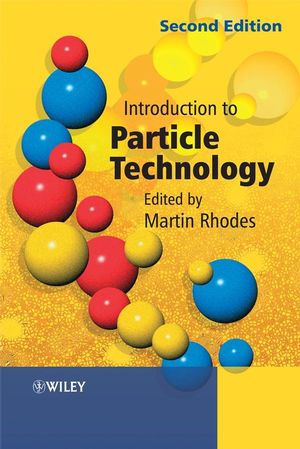Introduction to Particle Technology, 2nd EditionISBN: 978-0-470-01428-8
Paperback
472 pages
April 2008
 This is a Print-on-Demand title. It will be printed specifically to fill your order. Please allow an additional 10-15 days delivery time. The book is not returnable.
Other Available Formats: Hardcover
|
||||||
Preface to the Second Edition.
Preface to the First Edition.
Introduction..
1. Particle Size Analysis.
1.1 Introduction.
1.2 Describing The Size Of A Single Particle.
1.3 Description Of Populations Of Particles.
1.4 Conversion Between Distributions.
1.5 Describing The Population By A Single Number.
1.6 Equivalence Of Means.
1.7 Common Methods Of Displaying Size Distributions.
1.8 Methods Of Particle Size Measurement.
1.9 Sampling.
1.10 Worked Examples.
Test Yourself.
Exercises.
2. Single Particles in a Fluid.
2.1 Motion Of Solid Particles In A Fluid.
2.2 Particles Falling Under Gravity Through A Fluid.
2.3 Non-Spherical Particles.
2.4 Effect Of Boundaries On Terminal Velocity.
2.5 Further Reading.
2.6 Worked Examples.
Test Yourself.
Exercises.
3. Multiple Particle Systems.
3.1 Settling Of A Suspension Of Particles.
3.2 Batch Settling.
3.3 Continuous Settling.
3.4 Worked Examples.
Test Yourself.
Exercises.
4. Slurry Transport.
4.1 Introduction.
4.2 Flow Condition.
4.3 Rheological Models For Homogeneous Slurries.
4.4 Heterogeneous Slurries.
4.5 Components Of A Slurry Flow System.
4.6 Further Reading.
4.7 Worked Examples.
Exercises.
Test Yourself.
5. Colloids and Fine Particles.
5.1 Introduction.
5.2 Brownian Motion.
5.3 Surface Forces.
5.4 Result of Surface Forces on Behaviour in Air and Water.
5.5 Influences of Particle Size and Surface Forces on Solid/Liquid Separation by Sedimentation.
5.6 Suspension Rheology.
5.7 Influence of Surface Forces on Suspension Flow.
5.8 Nanoparticles.
5.9 Worked Examples.
Test Yourself.
Exercises.
6. Fluid Flow Through a Packed Bed of Particles.
6.1 Pressure Drop–Flow Relationship.
6.2 Filtration.
6.3 Further Reading.
6.4 Worked Examples.
Test Yourself.
Exercises.
7. Fluidization.
7.1 Fundamentals.
7.2 Relevant Powder And Particle Properties.
7.3 Bubbling And Non-Bubbling Fluidization.
7.4 Classification Of Powders.
7.5 Expansion Of A Fluidized Bed.
7.6 Entrainment.
7.7 Heat Transfer In Fluidized Beds.
7.8 Applications Of Fluidized Beds.
7.9 A Simple Model For The Bubbling Fluidized Bed Reactor.
7.10 Some Practical Considerations.
7.11 Worked Examples.
Test Yourself.
Exercises.
8. Pneumatic Transport and Standpipes.
8.1 Pneumatic Transport.
8.2 Standpipes.
8.3 Further Reading.
8.4 Worked Examples.
Test Yourself.
Exercises.
9. Separation of Particles From a Gas: Gas Cyclones.
9.1 Gas Cyclones – Description.
9.2 Flow Characteristics.
9.3 Efficiency Of Separation.
9.4 Scale-Up Of Cyclones.
9.5 Range Of Operation.
9.6 Some Practical Design And Operation Details.
9.7 Worked Examples.
Test Yourself.
Exercises.
10. Storage and Flow of Powders – Hopper Design.
10.1 Introduction.
10.2 Mass Flow And Core Flow.
10.3 The Design Philosophy.
10.4 Shear Cell Test.
10.5 Analysis Of Shear Cell Test Results.
10.6 Summary Of Design Procedure.
10.7 Discharge Aids.
10.8 Pressure On The Base Of A Tall Cylindrical Bin.
10.9 Mass Flow Rates.
10.10 Conclusions.
10.11 Worked Examples.
Test Yourself.
Exercises.
11. Mixing and Segregation.
11.1 Introduction.
11.2 Types Of Mixture.
11.3 Segregation.
11.4 Reduction Of Segregation.
11.5 Equipment For Particulate Mixing.
11.6 Assessing The Mixture.
11.7 Worked Examples.
Exercises.
12. Particle Size Reduction.
12.1 Introduction.
12.2 Particle Fracture Mechanisms.
12.3 Model Predicting Energy Requirement And Product Size Distribution.
12.4 Types Of Comminution Equipment.
12.5 Worked Examples.
Test Yourself.
Exercises.
13. Size Enlargement.
13.1 Introduction.
13.2 Interparticle Forces.
13.3 Granulation.
13.4 Worked Examples.
Exercises.
14. Health Effects of Fine Powders.
14.1 Introduction.
14.2 The Human Respiratory System.
14.3 Interaction of Fine Powders with the Respiratory System.
14.4 Pulmonary Delivery of Drugs.
14.5 Harmful Effects of Fine Powders.
Test Yourself.
Exercises.
15. Fire and Explosion Hazards of Fine Powders.
15.1 Introduction.
15.2 Combustion Fundamentals.
15.3 Combustion In Dust Clouds.
15.4 Control Of The Hazard.
15.5 Worked Examples.
Test Yourself.
Exercises.
16. Case Studies.
16.1 Case Study 1.
16.2 Case Study 2.
16.3 Case Study 3.
16.4 Case Study 4.
16.5 Case Study 5.
16.6 Case Study 6.
16.7 Case Study 7.
16.8 Case Study 8.
Notation.
References.
Index.



